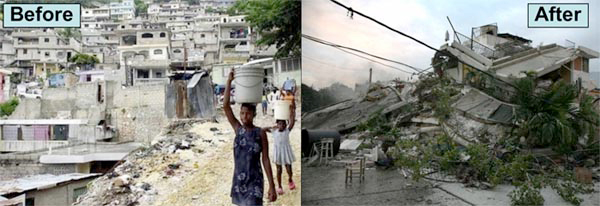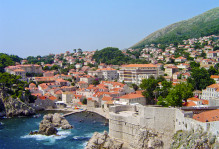From the Belly of the Earth
For many, geology and the earth sciences resides in the realm of the interesting and curious, it is neither essential nor critical to society and the modern world. Diamonds and jade, coveted luxury objects, form way below the surface and long ago. Dinosaurs fascinate young and old alike, but let’s face it, dinosaurs are dead. The Grand Canyon, a mighty cleft in the Earth draws millions of visitors gawking to its edge, but for most it’s merely another scenic attraction far removed from modern life.
The first few months of 2010 have brought geology to the fore. On Jan. 12th, rupture along the Enriquillo-Plantain Garden Fault generated an earthquake that reduced Port-au-Prince to rubble and brought suffering at a horrific scale. A month later the 5th largest earthquake in the last century shoved much of south-central Chile westward, producing a tsunami and leaving destruction in its wake. Earlier this month landslides in Rio de Janeiro buried neighborhoods and people alike. Last week an Icelandic volcano threw out clouds of ash that have buggered up European air travel and international commerce ever since.

Before and after images from Port-au-Prince, Haiti. Countless unreinforced masonry buildings collapsed during the January 12th earthquake. Images modified from presentation available at http://www.iris.edu/hq/retm
Mayhem spawned from the belly of the Earth. Catastrophic events command our attention, but this run of quakes and eruptions will surely pass out of our collective consciousness soon enough and the role that Geology plays in human affairs slip from public view.

Time series photographs of rapidly ascending ash plume rising above Mount Redoubt, Alaska on March 27th 2009- volcanic ash is very bad for jet aircraft engines (Photos courtesy of UPS Captain Ralph Rex).
It is the season for high school seniors to select a college and the William & Mary campus is crawling with accepted students. I commonly speak at on-campus events for accepted students and their parents; I try to paint a picture of the W&M academic experience. Invariably at the end of the question-and-answer session a parent will come forward to chat and make a comment along the lines of “my daughter is going to major in Government and then go on to law school, maybe she’ll have time for a geology class- sounds interesting, but you can’t really do anything with a Geology degree“. My skills as a diplomat are frightfully limited and situations like this test my mettle. Parents should be concerned with their children’s future, but there is no clean and clear-cut academic path to reach long-term success.
Since 1996 I’ve advised nearly 70 W&M geology majors on their senior research projects- many of my students go on to earn Master’s and doctoral degrees in the earth sciences, but plenty have gone on to careers in law, education, business, and even the clergy. My message for parents is to step back and offer perspective to your children, but avoid being prescriptive. For students- follow your interests, but also be open to the wide range of academic opportunities that William & Mary affords. Many people end up successful and satisfied in careers far afield from their major course of study.
If you want my perspective keep reading- society needs more earth scientists. Seismologists studying earthquakes and their precursory behavior may well devise real-time early warning systems that will save lives. Better remote sensing of volcanic ash clouds and atmospheric dispersal mechanisms will improve decision-making about grounding aircraft. Volcanic exhalations and devastating temblors are not the only exigencies that require earth scientists. In the past two years the call to drill for oil off the East Coast reached a fever pitch; President Obama recently opened millions of acres to exploration. But just how much oil and natural gas is contained in these offshore deposits? Modern agriculture puts a plethora of chemicals into aquifers- where do those chemicals go and what are the consequences? The geologic record is rich with information on past climate and environmental change, but how to read that record and use it to inform society on future change? Earth scientists will provide answers to those questions and many more critical to the modern world. Many of those earth scientists will come from William & Mary.




No comments.
Comments are currently closed. Comments are closed on all posts older than one year, and for those in our archive.